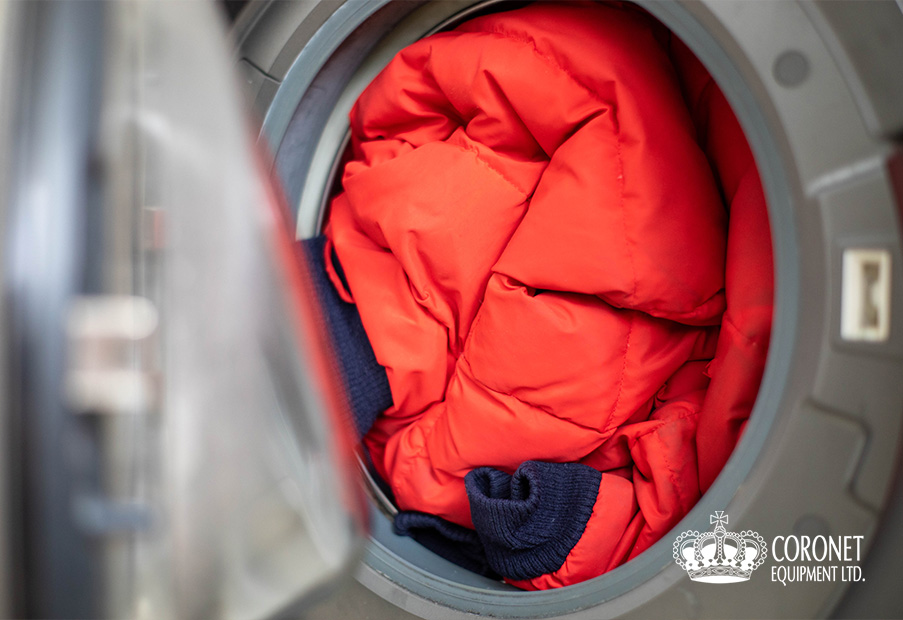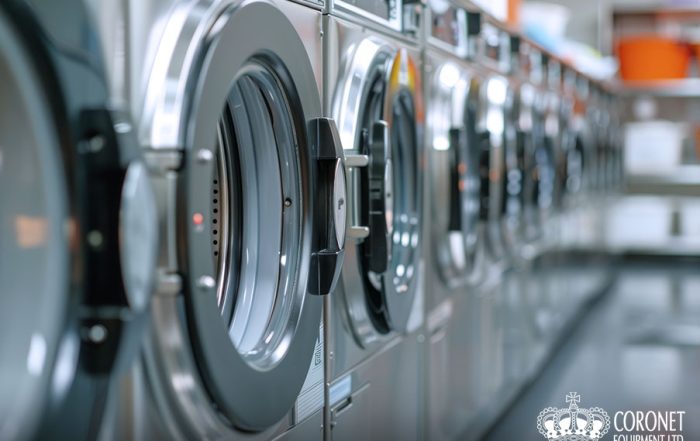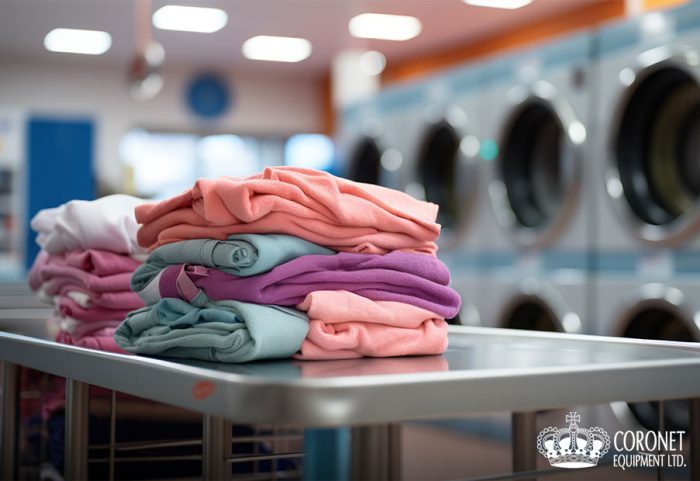Get Your Winter Gear Ready: Tips for Industrial and Residential Machines
Whether we like it or not, winter is on its way and that means getting our winter gear ready. Maybe you’re an avid ski bunny who’s counting the days until you can hit the slopes, or maybe (like me) you only plan to step outside for as long as it takes you to clear your driveway. Either way, read this blog to find out everything you need to know to get your gear clean before the snow flies.
Increasingly, we’re seeing homeowners opt for industrial machines for home use, given their enormous capacity and reputation for energy-efficiency and durable longevity. If you don’t have an industrial machine at home, you might want to take your heavy winter gear to a laundromat with larger machine capacities that can accommodate the additional bulk and weight.
If you’re opting for the convenience of using a smaller residential machine to clean your gear at home, make sure you read our tips to ensure that you don’t overburden your machine or cause premature wear and tear.
With winter just around the corner, Albertans will want to be ready, and Coronet Equipment has all the laundry tips you need to so that you’re prepared for the season ahead.
Industrial Machines: Power and Precision for Bulk Cleaning
Industrial washing machines are workhorses designed to handle large volumes of laundry efficiently. They’re often found in laundromats, hotels, or other businesses where cleanliness matters. These machines are also your go-to solution for winter gear cleaning.
If you already own an industrial washer, congratulations! These are a solid laundry investment with incredible longevity and enhanced capacity. However, most laundromats also offer industrial-sized machines for clients looking to use them on occasion, like for washing bulky winter wear.
To make the most of your laundry loads in an industrial machine, make sure you follow these tips:
1 Load Smart and Sort Wisely
With industrial machines, you can process large loads, but it’s still essential to load and sort your winter gear correctly. Overloading can compromise cleaning quality and machine durability. Separate you gear by material and colour, avoiding washing heavily soiled items with lighter ones.
2 Choose the Right Detergent
Select a high-quality detergent designed for industrial washing machines. Look for options that are suitable for both top-loading and front-loading machines to ensure optimal cleaning results.
3 Set the Correct Water Temperature
Different winter gear materials require specific water temperatures. Generally, cold water is suitable for delicate fabrics, while heavier items benefit from warmer water. Refer to care labels for precise temperature guidelines.
4 Use Fabric Softeners Wisely
While fabric softeners can make your winter gear feel softer, using them excessively can leave residue that affects insulation and water-proofing capabilities. Consider using softeners sparingly or opt for ones designed for technical fabrics. Better yet, just omit them when washing your winter gear.
5 Gentle Cycles for Delicate Items
For delicate winter gear, select a gentle cycle that prevents excessive agitation and minimizes wear and tear. This can be especially important for smaller, softer items like toques, scarves, and mittens. Some industrial machines offer specialized cycles for delicate fabrics.
6 Regular Maintenance is Key
Like any machinery, industrial washing machines require regular maintenance to function at their best. Follow the manufacturer’s guidelines for upkeep, including cleaning the lint filter and checking for any signs of wear.
Residential Machines: Convenience and Care for Home Cleaning
While industrial machines are ideal for large-scale winter gear cleaning, there are still plenty of items that can be washed in a residential machine. If you’re opting to clean winter gear in a smaller residential machine, here’s how to maximize your efforts:
1 Load Sensibly and Separate Your Gear
Residential machines have limited capacities, so load them sensibly to avoid overloading. Separate winter gear by type and material to prevent colour bleeding and ensure thorough cleaning. You’ll want to keep your loads small so that the extra bulk doesn’t create unnecessary wear and tear on your machinery.
2 Opt for Appropriate Detergents
Choose detergents that are suitable for home machines and consider those designed for cold water washes. Avoid using too much detergent, as it can leave residues on your gear and affect their performance
3 Customize Water Temperature
Set the water temperature based on the care labels of your winter gear. Cold water is generally safe for most items, but heavier garments may benefit from warm or hot water to remove tough stains.
4 Delicate Cycles for Gentle Items
Residential machines offer a range of cycles. Opt for delicate cycles when washing sensitive fabrics and smaller knit items to minimize wear and tear.
5 Regular Cleaning and Maintenance
Clean your machine’s lint filter regularly and check for any blockages in the drain. It’s a good idea to occasionally run a hot water cycle with vinegar to eliminate odours and detergent build-up.
6 Dry with Care
After washing, check care labels to determine the best drying method for your winter gear. Some items may require air drying, while others can be safely tumble-dried on low heat.
General Tips for All Machines
Regardless of whether you’re using an industrial or residential machine, following some basic best practices can help to ensure that your laundry comes out perfectly every time.
1 Inspect and Repair
Before washing your winter gear, inspect it for any tears, loose buttons, or damaged zippers. Making the necessary repairs before washing will ensure your gear can withstand the laundering process as well as the winter elements.
2 Remove Stains
Tackle stains promptly by pretreating them before washing. There are various stain removal products available that cater to different types of stains and fabrics. If you’ve left your winter jackets in a pile since last spring (no judgement!) you might need to let your stains sit in stain removing solution overnight or scrub them with some extra elbow grease before washing.
3 Follow Care Labels
Care labels provide crucial information for cleaning and maintaining your winter gear. Always adhere to the recommended cleaning instructions to extend the life of your items.
4 Dry Thoroughly
Ensure that your winter gear dries completely to prevent mold and odours. Thick, heavy coats might require more than one dryer cycle. You can increase movement and air flow in the dryer by using reusable wool or plastic dryer balls to keep your items circulating well. Use hangers or drying racks to air-dry items that can’t go in the dryer.
5 Store Properly
When winter ends, store your clean gear in a cool, dry place. Avoid sealing items in plastic bags, as moisture can accumulate and cause damage. Use breathable storage containers instead. It’s best to wash your items at the end of the season so that you can store them without worrying about staining and odours, but hey, we know life is busy and there’s no shame in washing them now before the snow returns!
Get Set for Winter
Winter gear cleaning is an essential part of preparing for the cold season. Whether you have access to an industrial washing machine for large volumes or using a residential machine at home, following these expert tips will help you maintain your winter gear effectively.
With proper care and cleaning, your gear will be fresh, clean, and ready to keep you warm throughout the winter. So, gear up and embrace the season with confidence.
Recent Posts
Tips for Maintaining Your Commercial Washing Machine
Commercial washing machines are renowned for their efficiency, durability, and superior cleaning performance. Using one can significantly enhance your laundry experience, allowing you to handle larger loads and tougher stains with ease. Want to learn [...]
The Role of Industrial Laundry in Healthcare
In healthcare, cleanliness is crucial. Clean linens play a big role in this, helping prevent the spread of germs and making patients feel comfortable and cared for. Industrial laundry services are essential for keeping healthcare [...]
Salons and Spas Need Industrial Laundry Machines
Ever since a serious slump during the 2020 pandemic, salons and spas have been expanding and innovating. The pandemic also highlighted the need for sanitizing in the beauty industry, where cleanliness was already a top [...]




